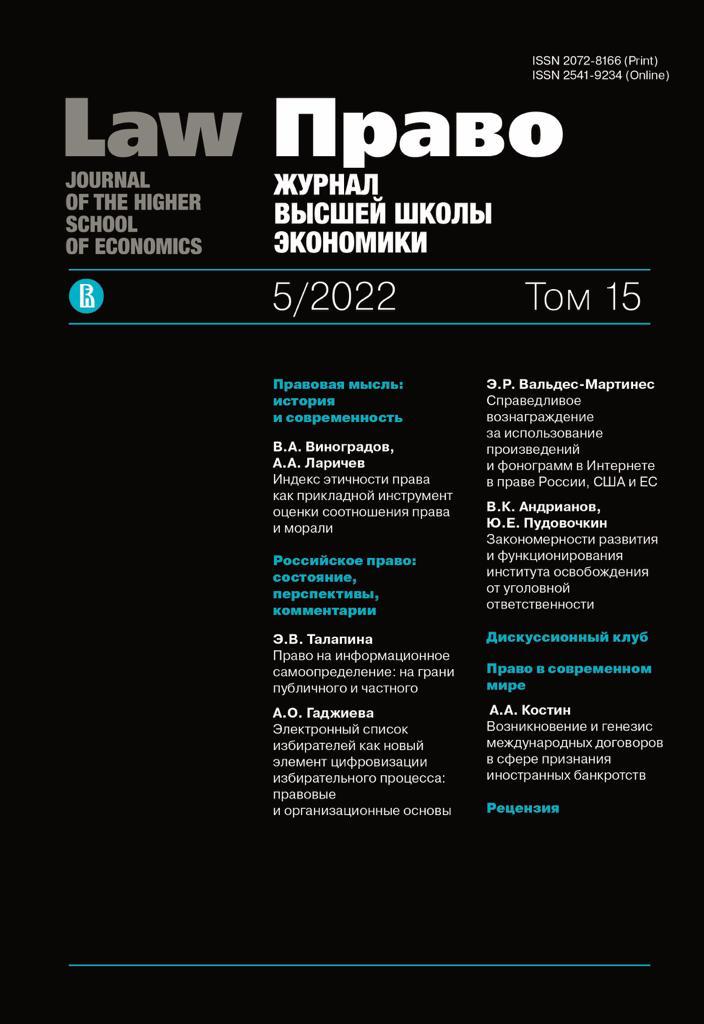Autonomy of the European Union Law: External Dimension and Role in Process of the EU Constitutionalization
Abstract
The principle of autonomy of the European Union law which sparked intensive debates after Kadi-1 judgment of the European Court of Justice and its Opinion No 2/13, is widely recognized as one of the key general principles of the Union law. The article suggests that the principle of autonomy plays a crucial role in the ongoing transformation of the European Union into a sort of quasi-federation in dynamics where the Court of Justice aims to arrange a sectoral transfer of sovereign powers from the EU member-states states on the level of that quasi-federation. The results of the practical application by the Court of Justice of the EU of “external dimension” of the principal of autonomy (articulating that EU law is not a part of international law) reveals intentions of the Court of Justice independently and according to its own rules decide the issues of validity and applicability of the norms of international law in the legal order of the European Union. The same must be said about the control from the side of the EU Court of Justice of international treaties concluded by the EU member-states as subjects of such quasi-federation and by the Union itself. A remarkable similarity between arguments used by the Court of Justice of the EU in such issues and reasoning of national constitutional courts of some European countries provides feasible grounds for an assumption to consider the EU Court of Justice as a sort of constitutional court of emerging quasi-federation which protect and secure a gradual sectoral transfer of sovereignty from the EU member states on the Union level. But it should not be taken as a legal autarchy from the side of the EU or a construction of insurmountable wall between EU law and international law. It is better to be views as a right of the Court of Justice of the EU to determine how international legal obligation of the EU or its member-states may affect autonomy of the EU legal order. From this point of view any accusations addressed to the Court of Justice of the EU in adding further fragmentation of international law look as missing a point because the Court of Justice takes European Union law as law of emerging quasi-federation, not as international law.
References
Collins R., White N. (2011) International organizations and the idea of autonomy: introduction and overview. In: International Organizations and the Idea of Autonomy Institutional Independence in the International Legal Order. R. Collins, N. White (eds.). N.Y.: Routledge, pp. 1-20. DOI: https://doi.org/10.4324/9780203828090
D'Aspremont J., Dopagne F. (2008) Two constitutionalisms in Europe: pursuing an articulation of the European and international legal order. Heidelberg Journal of International Law, vol. 68, pp. 939-977.
Dautricourt C. (2010) A Strasbourg perspective on the autonomous development of fundamental rights in EU Law: trends and implications. Jean Monnet Working Paper, no. 10, pp. 1-70.
De Burka G. (2010) The European Court of Justice and the international legal order. Harvard International Law Review, vol. 51, no. 1, pp. 1-52.
De Wet E. (2006) The international constitutional order. The International and Comparative Law Quarterly, vol. 55, no. 1, pp. 51-76. DOI: https://doi.org/10.1093/iclq/lei067
De Witte B. (1994) Rules of change in international law: how special is the European Community? Netherlands Yearbook of International Law, vol. 25, pp. 299-331. DOI: https://doi.org/10.1017/S0167676800000258
De Witte B. (2008) The emergence of a European System of public international law: The EU and its member states as strange subjects. In: The Europeanisation of International Law: The Status of International Law in the EU and its Member States. J. Wouters et al. (eds.). The Hague: Asser Press, pp. 39-54. DOI: https://doi.org/10.1007/978-90-6704-639-8_3
D'yachenko E.B., Entin K.V. (2018) The law of Euroasian Economic Union and practice of its Court. Zhurnal rossiyskogo prava = Journal of Russian law, no. 10, pp. 123-133 (in Russ.)
Eckes C. (2010) International law as law of the EU: The role of the Court of Justice. CLEER Working papers, no. 6.
Eckes C. (2012) Protecting supremacy from external influences: A precondition for a European constitutional legal order? European Law Journal, vol. 18, pp. 230-250. DOI: https://doi.org/10.1111/j.1468-0386.2011.00595.x
Eckes C. (2019) Some reflections on Achmea's broader consequences for investment arbitration. European Papers, vol. 4, no. 1, pp. 79-97.
Eckes C. (2020) The autonomy of the EU legal order. Europe and the World: A Law Review, vol. 4, no. 1, pp. 1-19. DOI: https://doi.org/10.14324/111.444.ewlj.2019.19
Eeckhout P. (2015) Opinion 2/13 on EU accession to the ECHR and judicial dialogue: autonomy or autarky. Fordham International Law Journal, vol. 38, no. 4, pp. 955-992. DOI: https://doi.org/10.2139/ssrn.2605821
Fanou M. (2020) CETA ICS and autonomy of the EU legal order in Opinion 1/17. Cambridge Yearbook of European Legal Studies, vol. 22, pp. 106-113. DOI: https://doi.org/10.1017/cel.2020.4
Fassbender B. (1998) UN Charter as constitution of the international community. Columbia Journal of Transnational Law, vol. 36, no. 3, pp. 529-619.
Halberstam D. (2015) “It's the autonomy, stupid!” A modest defense of opinion 2/13 on EU accession to the ECHR, and the way forward. German Law Journal, vol. 16, no. 1, pp. 105-146. DOI: https://doi.org/10.1017/S2071832200019441
Kassoti E., Odermatt J. (2020) The principle of autonomy and international investment arbitration: reflections on Opinion 1/17. Questions of International Law, vol. 73, pp. 5-20.
Klabbers J. (2012) Validity of EU norms conflicting with international obligations. In: International Law as Law of the European Union. E. Cannizzaro et al. (eds.). Leiden: Martinus Nijhoff, pp. 111-131. DOI: https://doi.org/10.1163/9789004215528_007
Koutrakos P. (2019) The autonomy of EU law and international investment arbitration. Nordic Journal of International Law, vol. 88, no. 1, pp. 41-64. DOI: https://doi.org/10.1163/15718107-088010003
Lavranos N. (2010) Protecting European law from international law. European Foreign Policy Review, vol. 5, no. 2, pp. 265-228. DOI: https://doi.org/10.54648/EERR2010019
Lifshits I.M. (2020) International finance law and law of EU: interaction and mutual influence. Moscow: Yustitsinform, 548 p. (in Russ.)
Lifshits I.M. (2019) EU member states international treaties with third sides in EU Court practice. Mezhdunarodnoe pravosudie = International Justice, no. 3, pp. 84-101 (in Russ.) DOI: https://doi.org/10.21128/2226-2059-2019-3-84-101
Molnár T. (2015) Concept of EU Law autonomy from the comparative perspective of international law and the legal systems of member states. Hungarian Yearbook of International Law and European Law. The Hague: Eleven International Publishing, pp. 433-459. DOI: https://doi.org/10.5553/HYIEL/266627012015003001021
Moreno-Lax V., Gragl P. (2016) Beyond monism, dualism, pluralism: the quest for a (fully-fledged) theoretical framework: co-implication, embeddedness, and interdependency between public international law and EU law. Yearbook of European Law, vol. 35, pp. 455-470. DOI: https://doi.org/10.1093/yel/yew016
Moreno-Lax V. (2019) The axiological emancipation of a (non-) principle: autonomy, international law and the EU legal order. In: The Interface Between EU and International Law. Contemporary Reflections. I. Govaere, S. Garben (eds.). Chicago: Hart Publishing, pp. 45-71. DOI: https://doi.org/10.5040/9781509923410.ch-002
Odermatt J. (2016) When a fence becomes a cage: the principle of autonomy in EU external relations law. EUI Working Papers 2016/07, pp. 1-19.
Parish M. (2012) International courts and the European legal order. European Journal of International Law, vol. 23, no. 1, pp. 141-153. DOI: https://doi.org/10.1093/ejil/chs003
Pimenova S.D. (2018) Reform of investments arbitrage from position of EU: issues and prospects. Mezhdunarodnoe pravosudie = International Justice, no. 4, pp. 113-125 (in Russ.)
Rosas A. (2011) The status in EU Law of international agreements concluded by EU member states. Fordham International Law Journal, vol. 34, no. 5, pp. 1304-1345.
Simma B., Pulkowski D. (2006) Of planets and the universe: self-contained regimes in international law. European Journal of International Law, vol. 17, no. 3, pp. 483-529. DOI: https://doi.org/10.1093/ejil/chl015
Scheinin M. (2014) CJEU Opinion 2/13. Three mitigating circumstances. Available at: http://www.verfassungsblog.de/cjeu-opinion-213-three-mitigating-circumstances (accessed: 19.06. 2021)
Stein E. (1981) Lawyers, judges and the making of a transnational constitution. American Journal of International Law, vol. 75, no. 1, pp. 1-27. DOI: https://doi.org/10.2307/2201413
Tomusdiat C. (2009) The Kadi case: what relationship is there between the universal legal order under the auspices of the United Nations and the EU legal order? British Yearbook of European Law, vol. 28, no. 1, pp. 654-663. DOI: https://doi.org/10.1093/yel/28.1.654
Vesterdorf B. (2006) Constitutional court for the EU? International Journal of Constitutional Law, vol. 4, no. 4, pp. 607-617. DOI: https://doi.org/10.1093/icon/mol026
Wessel R. (2011) Reconsidering the relationship between International and EU law: towards a content-based approach? In: International Law as Law of the European Union. E. Cannizzaro et al. (eds.). Leiden: Martinus Nijhoff, pp. 5-33. DOI: https://doi.org/10.1163/9789004215528_003
Wouters J., Odermatt J, Ramopoulos T. (2014) Worlds apart? Comparing the approaches of the European Court of Justice and the EU Legislature to international law. In: The European Court of Justice and External Relations Law: Constitutional Challenges. M. Cremona, A.Thies (eds.). Oxford: University Press, pp. 249-279.
Ziegler K. (2017) Autonomy: from myth to reality — or Hubris on a tightrope? EU law, human rights and international law. In: Research Handbook on EU Human Rights Law. S. Douglas-Scott et al. (eds.). Cheltenham: Edward Elgar, pp. 267-307. DOI: https://doi.org/10.4337/9781782546405.00022
Copyright (c) 2022 Law Journal of the Higher School of Economics

This work is licensed under a Creative Commons Attribution-ShareAlike 4.0 International License.


















